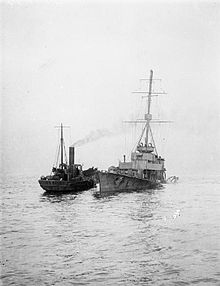HMS Arethusa (1913)
Design and description
The Arethusa-class cruisers were intended to lead destroyer flotillas and defend the fleet against attacks by enemy destroyers. The ships were 456 feet 6 inches (139.1 m) long overall, with a beam of 49 feet 10 inches (15.2 m) and a deep draught of 15 feet 3 inches (4.6 m). Displacement was 5,185 long tons (5,268 t) at normal and 5,795 long tons (5,888 t) at full load. Arethusa was powered by four Brown-Curtis steam turbines, each driving one propeller shaft, which produced a total of 40,000 shaft horsepower (30,000 kW). The turbines used steam generated by eight Yarrow boilers which gave her a speed of about 28.5 knots (52.8 km/h; 32.8 mph). She carried 840 long tons (853 t) of fuel oil that gave a range of 3,200 nautical miles (5,900 km; 3,700 mi) at 16 knots (30 km/h; 18 mph).
The main armament of the Arethusa-class ships consisted of two BL 6-inch (152 mm) Mk XII guns that were mounted on the centreline fore and aft of the superstructure and six QF 4-inch (102 mm) Mk V guns in waist mountings. They were also fitted with a single QF 3-pounder 47 mm (1.9 in) anti-aircraft gun and four 21-inch (533 mm) torpedo tubes in two twin mounts.
Construction and career

She was laid down at Chatham Dockyard in October 1912, launched on 25 October 1913, and commissioned in August 1914 as flotilla leader for the Harwich Force. On 28 August 1914, she fought at the Battle of Heligoland Bight, flying the flag of Commodore Reginald Tyrwhitt. She was seriously damaged by the German cruisers SMS Frauenlob and Stettin and had to be towed home. On 25 December, Arethusa took part in the Cuxhaven Raid and on 24 January 1915 she fought at the Battle of Dogger Bank. Later in the same year, she was transferred to the 5th Light Cruiser Squadron of the Harwich Force. In September 1915, she captured four German trawlers. On 11 February 1916, she struck a mine off Felixstowe, drifted onto a shoal while under tow, and broke her back. Approximately near Harwich (51.925, 1.295)
Legacy
One of the four relief panels on Brierley Hill War Memorial, in Dudley, England, depicts Arethusa sending out its boats to rescue German sailors from a ship it had sunk.
One of Arethusa's 4-inch guns was salvaged from the wreck on 27 March 1916. It was fitted to the yacht Vittoria, serving as a minesweeper, until 27 February 1918. It was then taken on by the drill ship HMS Satellite on 25 September 1920, where it was used in anti-submarine training until the beginning of the Second World War. It was presented by the shipbreaking firm J. G. Potts to the Armstrong & Aviation Museum at Bamburgh Castle on 16 February 1948, where it remains as of 2024.
Notes
- ^ Colledge, J J (1972). British Warships 1914–1919. Shepperton: Ian Allan. p. 47.
- ^ Friedman 2010, p. 384
- ^ Gardiner & Gray, p. 55
- ^ Pearsall, Part I, p. 210
- ^ Gardiner & Gray, pp. 55–56
- ^ "H.M.S. Arethusa (1913) - the Dreadnought Project".
- ^ Dittmar; Colledge. British Warships 1914–1919. p. 47
- ^ "War Memorials". Dudley Metropolitan Borough Council.
- ^ Four Inch Gun, Mark V, Reg. No. 946 (Museum sign). Bamburgh Castle: Armstrong & Aviation Museum.
Bibliography
- Colledge, J. J.; Warlow, Ben (2006) [1969]. Ships of the Royal Navy: The Complete Record of all Fighting Ships of the Royal Navy (Rev. ed.). London: Chatham Publishing. ISBN 978-1-86176-281-8.
- Corbett, Julian (March 1997). Naval Operations to the Battle of the Falklands. History of the Great War: Based on Official Documents. Vol. I (2nd, reprint of the 1938 ed.). London and Nashville, Tennessee: Imperial War Museum and Battery Press. ISBN 0-89839-256-X.
- Corbett, Julian (1997). Naval Operations. History of the Great War: Based on Official Documents. Vol. II (reprint of the 1929 second ed.). London and Nashville, Tennessee: Imperial War Museum in association with the Battery Press. ISBN 1-870423-74-7.
- Friedman, Norman (2010). British Cruisers: Two World Wars and After. Barnsley, South Yorkshire, UK: Seaforth. ISBN 978-1-59114-078-8.
- Friedman, Norman (2011). Naval Weapons of World War One. Barnsley, South Yorkshire, UK: Seaforth. ISBN 978-1-84832-100-7.
- Gardiner, Robert & Gray, Randal, eds. (1985). Conway's All the World's Fighting Ships 1906–1921. Annapolis, Maryland: Naval Institute Press. ISBN 0-85177-245-5.
- Newbolt, Henry (1996). Naval Operations. History of the Great War Based on Official Documents. Vol. V (reprint of the 1931 ed.). Nashville, Tennessee: Battery Press. ISBN 0-89839-255-1.
- Pearsall, Alan (1984). "Arethusa Class Cruisers, Part I". Warship. VIII. London: Conway Maritime Press: 203–11. ISBN 0-87021-983-9.
- Pearsall, Alan (1984). "Arethusa Class Cruisers, Part II". Warship. VIII. London: Conway Maritime Press: 258–65. ISBN 0-87021-983-9.